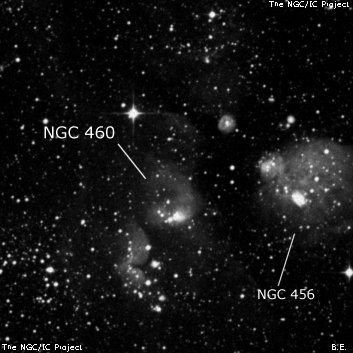
The fainter southeast section has some stars involved (Lindsay 97), including mag 12.5 Sk 155, a massive O9-type star and mag 14.2 SMC-N84B, an emission-line "star" [resolved by HST as a compact HII knot]. Located 4' ESE of NGC 456 with NGC 465 a similar distance southeast. A mag 10 star is close north.
James Dunlop possibly discovered NGC 460 = D 8? = h2402 in 1826 with his 9" reflector and described a "a small oval nebula, about 10" diameter" and his position is just 2' NE of this nebulous cluster. The close match in position might be a pure coincidence given Dunlop's poor positions.
In any case, this SMC cluster/nebula was discovered by JH on 11 Apr 1834 and observed on 4 sweeps. Described as the second of three nebulous clusters with NGC 456 (observed 3 times) and NGC 465 (observed once). JH placed h2402 at a mean position of 01 14 40 -73 18.2 (2000) and this position was used in the GC and NGC. Nevertheless, the declination given in RNGC, Deep Sky Field Guide (first edition only), NGC 2000.0 and Uranometria 2000 Atlas (first edition only) is one degree too far north. The declination given in ESO is correct.
400/500mm - 18" (7/6/02 - Magellan Observatory, Australia): this is the second of three SMC clusters with NGC 456 and NGC 465 in a chain. At 128x and UHC filter, two close nebulous patches roughly oriented NW-SE were visible, separated by a dusky lane oriented SW-NE. The total diameter is ~2.5'. The northwest component, which corresponds with John Herschel's position, has a very small knot or star (SMC-N84A) at the south end.
Notes by Steve Gottlieb